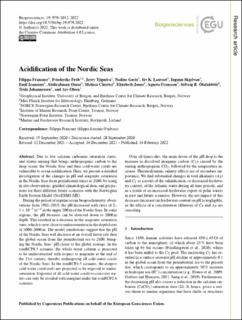| dc.contributor.author | Fransner, Sara Filippa Krusmynta | |
| dc.contributor.author | Fröb, Friederike | |
| dc.contributor.author | Tjiputra, Jerry | |
| dc.contributor.author | Goris, Nadine | |
| dc.contributor.author | Lauvset, Siv Kari | |
| dc.contributor.author | Skjelvan, Ingunn | |
| dc.contributor.author | Jeansson, Emil | |
| dc.contributor.author | Omar, Abdirahman | |
| dc.contributor.author | Chierici, Melissa | |
| dc.contributor.author | Jones, Elizabeth Marie | |
| dc.contributor.author | Fransson, Agneta | |
| dc.contributor.author | Ólafsdóttir, Sólveig R. | |
| dc.contributor.author | Johannessen, Truls | |
| dc.contributor.author | Olsen, Are | |
| dc.date.accessioned | 2022-08-12T10:33:11Z | |
| dc.date.available | 2022-08-12T10:33:11Z | |
| dc.date.created | 2022-02-16T09:52:01Z | |
| dc.date.issued | 2022 | |
| dc.identifier.citation | Biogeosciences. 2022, 19 979-1012. | en_US |
| dc.identifier.issn | 1726-4170 | |
| dc.identifier.uri | https://hdl.handle.net/11250/3011575 | |
| dc.description.abstract | Due to low calcium carbonate saturation states, and winter mixing that brings anthropogenic carbon to the deep ocean, the Nordic Seas and their cold-water corals are vulnerable to ocean acidification. Here, we present a detailed investigation of the changes in pH and aragonite saturation in the Nordic Seas from preindustrial times to 2100, by using in situ observations, gridded climatological data, and projections for three different future scenarios with the Norwegian Earth System Model (NorESM1-ME). | en_US |
| dc.language.iso | eng | en_US |
| dc.title | Acidification of the Nordic Seas | en_US |
| dc.title.alternative | Acidification of the Nordic Seas | en_US |
| dc.type | Peer reviewed | en_US |
| dc.type | Journal article | en_US |
| dc.description.version | publishedVersion | en_US |
| dc.source.pagenumber | 979-1012 | en_US |
| dc.source.volume | 19 | en_US |
| dc.source.journal | Biogeosciences | en_US |
| dc.identifier.doi | https://doi.org/10.5194/bg-19-979-2022 | |
| dc.identifier.cristin | 2002152 | |
| dc.relation.project | Norges forskningsråd: 294930 | en_US |
| cristin.ispublished | true | |
| cristin.fulltext | original | |
| cristin.qualitycode | 1 | |
